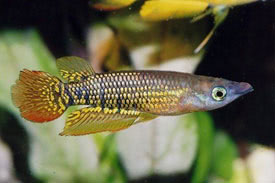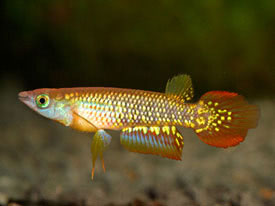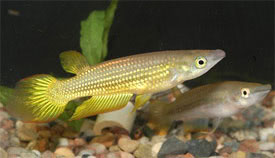
 Magyarul / Hungarian
Magyarul / Hungarian


- Scientific name: Aplocheilus lineatus
- Synonyms: Aplocheilus affinis, Aplocheilus rubropictus, Aplocheilus vittatus, Panchax lineatum
- Common name: Striped panchax, Lineatus panchax
- Group: Killifish
- Habitat: Asia; Sri Lanka, South India
- Size: 8-10 cm
- Biotope: In still and slow moving water with heavy vegetation in coastal regions of Southern India.
- Social behavior: A predatory species that can be combined with medium to large sized fishes. Malesare aggressive towards one another, as are females, and should not be kept together in tanks less than 36"(91 cm) in length. It is possible to keep several pairs in one tank, as the aggression tends to be evenlyspread.
- Diet: Live, fish fry, crustaceans, insect larvae, flying and aquatic insects, Tubifex, flakes, pellets, tablets.
- Breeding: Easy
- Tank: Minimum 120 litres
- Population: 4-5 fish for 120 litres
- Decoration: Use a cover of floating plants to diffuse the lighting. Use a tight-fitting cover as this species is a jumper.
- Temperature: 22-26 °C
- pH: 6-6,8
- Hardness: 5-20 NK°
- Lifespan: 4 years
Description: The body is elongated and the snout is up-turned. The back is slightly arched and thefins are rounded. The back is olive brown to bronze-brown, and the flanks are bronze to dark forest greenin color. Alternating scales are yellow-gold in color giving the fish an attractive appearance. Theseyellow scales continues ant the anal, caudal, and dorsal fins, which are bronze in color. The jaw and frontal belly regions areyellowish white and the iris of the eye may be green. Nine dark, transverse stripes mark the body of juveniles and maturefemales. At least two variants are common to the hobby: one with a fully red tail, and the other with themajority of the caudal fin is red, and the outer lobes are white. The anal and dorsal fins are yellow.
Males are larger and more colorful, with elongated fins and slimmer, fainter transversebands. In females, these bands are more distinct and broader.
For breeding a small 5.5 gallon (21 L) tank is sufficient. The pair should be conditioned separatelyfor a period of two to three weeks. Use acidic water with a pH from 6-6.7 and a temperature from 77-82°F(25-28°C). Furnish the tank with dense bunches of fine-leafed plants or Java Moss, and a cover offloating plants. The large eggs are deposited among surface and bunches of plants. Remove the eggs and place them intoa shallow tank. The eggs should hatch after 11-14 days, and the young can be fed on powdered dry foodsand Artemia nauplii. The fry develop at different rates, so they must be frequently sorted according to size.






























